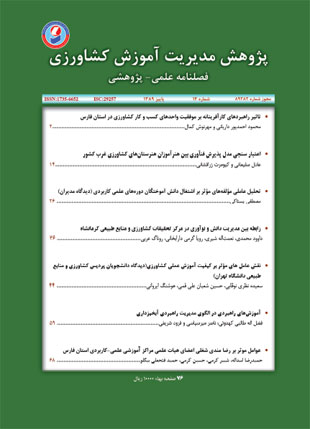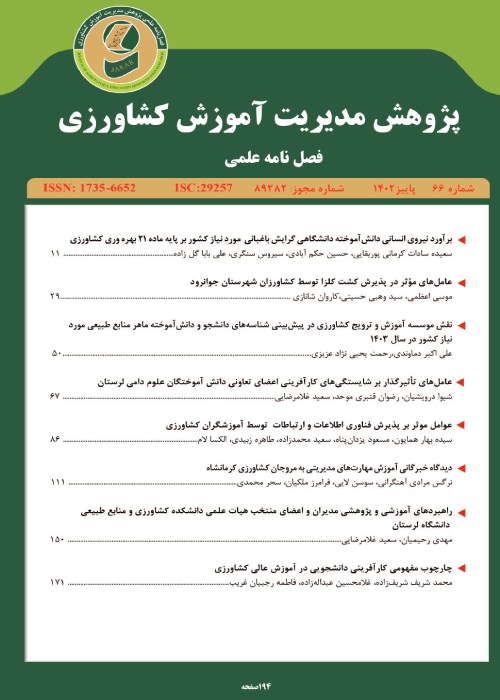فهرست مطالب

نشریه پژوهش مدیریت آموزش کشاورزی
سال دوم شماره 14 (پاییز 1389)
- تاریخ انتشار: 1389/08/18
- تعداد عناوین: 7
-
-
Page 2The main purpose of this study was to identify and analysis of entrepreneurial strategies affecting the performance of agricultural small and medium enterprises (SMEs). The statistical population included 1250 agricultural entrepreneurs in the SMEs in Fars province; by utilizing Cochrane’s formula 138 people were randomly selected. Descriptive and correlation results obtained from processing data by LISREL and SPSS software and also exploratory and confirmatory factor analysis methods, path analysis and structural equation models were studied. Result showed significant correlations between the components of SMEs successful performance and entrepreneurial strategies are there. On the other hand, based on our results, entrepreneurial strategies awareness, entrepreneurial strategies making and SMEs performance have shown positive and significant direct and indirect impacts on the successful performance of agricultural SMEs. These three factors explained 66.84 percent of the total variance. Finally, by applying structural equation modeling, the proposed model of successful performance of agricultural SMEs with appropriate path coefficients has been fitted.Keywords: Entrepreneurial Strategy, successful performance, agricultural SMEs, factor analysis, structural equation modeling
-
Page 14The purpose of this study was to determine the validity of Technology Acceptance Model (TAM) questionnaire (Davis, 1989) among agricultural vocational teachers across west of Iran. TAM is a multi-dimensional construct that includes five latent variables. A census of all agricultural vocational teachers was used to collect data (N = 154). Exploratory factor analysis was used to identify factor structure in TAM model and confirmatory factor analysis was used to test the model using structural equation modeling. Amos 16 was used to analyze the data. Results revealed that the data fits the model with RMSEA = 0.07, CFI = 0.91, NFI = 0.8, and IFI = 0.91. Results also showed a five factor structure for TAM model including “perceived ease of use”, “perceived usefulness” attitude towards using information technology”, Intention to use information technology”, and “the actual use”.Keywords: TAM Validity, Information technology, agricultural education
-
Page 26During past two decades, institute of technical and vocational higher education of The Jihad-e- Agriculture, for the propose of increasing and enhancing the level of technical knowledge of the producers and employees of agricultural sector and creating occupational opportunity for who are willing to find job, has planned and performed different courses, technician and bachelor levels. In this regard, identifying factors influencing and facilitating employment of the graduates is very important. This research was organized and conducted to identify some of these factors from the perspective of educational experts. This is an applied descriptive research for which data was collected via survey method. The Statistical population of research included91 technical and vocational education experts consisting heads of educational centers and administrators of their groups, administrators of institute of technical and vocational higher education at the different levels with at least five years’ experience in teaching and two years of experience in administration. The results of factor analysis showed that factors affecting employment of graduates, are to be divided in seven groups including: “Macro programming and policy”, “Cultural and other extracurricular “,“Educational content, quality of learning and teaching”, “system of admitting students”, “communication”, “interaction between training centers and production units” and “organizations”.Keywords: Technical, vocational education, factor analysis, employment of graduates
-
Page 36
The Propose of this research is to investigate relationship between knowledge management and innovation in Agricultural and Natural Resources Research Center personnel in Kermanshah Province. The nature of this research is applied, implemented by cause-correlational method. Statistical population is consisted of all agricultural research center personnel in Kermanshah province (N=60). The instrument for data collection in this research was structured and pretested questionnaire. The validity of the questionnaire was determined by the expert group and its reliability was calculated by using Cronbach's alpha coefficient (α= 0.87). Using census, the questionnaire was sent to the statistical population of which 52 questionnaires were completed and returned. Data analyzed by SPSSWin18. Results from Pearson correlation coefficients showed that there was positive relation between knowledge management and its triple components with employee's innovation at P=0.01 is significant and positive. Also, path analysis results showed that the variable, knowledge style had the highest effect (55.1%), and the variable of responsiveness to knowledge had the least effect (24.3%) on innovation. Totally, the independent variables of research explained 42.6% of variance in the dependent variable.
Keywords: Knowledge management, innovation, knowledge style -
Page 44The main purpose of this research was to determine the effective factors on the quality of practical education at the College of Agriculture, University of Tehran. This study was conducted by applying a dominant-less-dominant research approach (quantitative and qualitative, respectively). The statistical population comprised of 2032 junior and senior students of agriculture. The sample of the study consisted of 335 students using proportional stratified random sampling technique. The instrument was a researcher made questionnaire, that, its validity was approved the academic staff, department of Agricultural Extension Education. Reliability of the questionnaire was calculated by Cronbach's Alfa coefficients as α= 0.92. Statistical analysis was mainly done by applying multiple regression analysis. Findings indicated that there were eleven variables impacting the quality of practical higher agricultural education. These variables were: providing necessary accommodation for filed trip educational, practical courses satisfaction, major courses interest, receiving theoretical basis along with practical courses, up -dated lecturers, skilled technicians, well equipped computer sites, well organized agronomical and horticultural skills needed, positive impressions towards practical courses, higher secondary school GPA, and field experience. These variables, totally, could explain 42.2 percent of the total variance of the quality agricultural practical education.Keywords: Practical education, quality education, agricultural practical education
-
Page 59This research is conducted to design strategic education pattern to strategic watershed management project. The statistical population of the study consisted of 60 managers who are in change of planning, policy-making and directing watershed management activities at the department of watershed management; Forests, Pastures and Watershed Organization of the Ministry of Agriculture. In order to design the model in the process of research, in addition to paying attention to the objectives, dimensions of the subject and theoretical arguments, factors and variable involved in the research domain must be recognized. Therefore, in order to determine the influential factors and contingencies and their relation in line with designing and explorative the desirable model the analytical model has been used. The end, elaborate of the strategic educations managerial suitable for designed pattern.Keywords: Strategic management, watershed, sustainable development, watershed
-
Page 68
Productivity is one of the main concerns of managers in most organizations and institutions. Human capital should be considered as one of the most important resources of any organization and perhaps the most determining factor in productivity improvement, especially in service organizations. Job satisfaction of human resources is among the main factors affecting organizational productivity. The purpose of this study was to determine effective factors of faculty member's job satisfaction in applied science and Technology University in Fars province. A survey method was applied. Questionnaire face validity was confirmed and then reliability coefficient Cranach's alpha for the questionnaire was obtained (α=0.86) in a pilot study in Bushehr province. The results showed determined factors could predict 69.5% of job satisfaction variation. Main factors were personal characteristics and research conditions respectively. Among the determined factors, educational conditions had a negative effect on satisfaction.
Keywords: Job satisfaction, Applied, Science education, academic, staff


